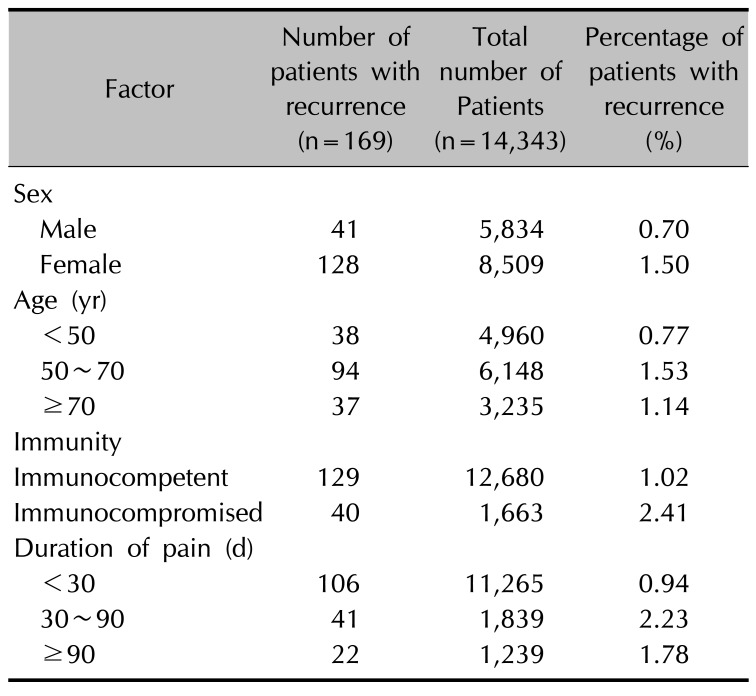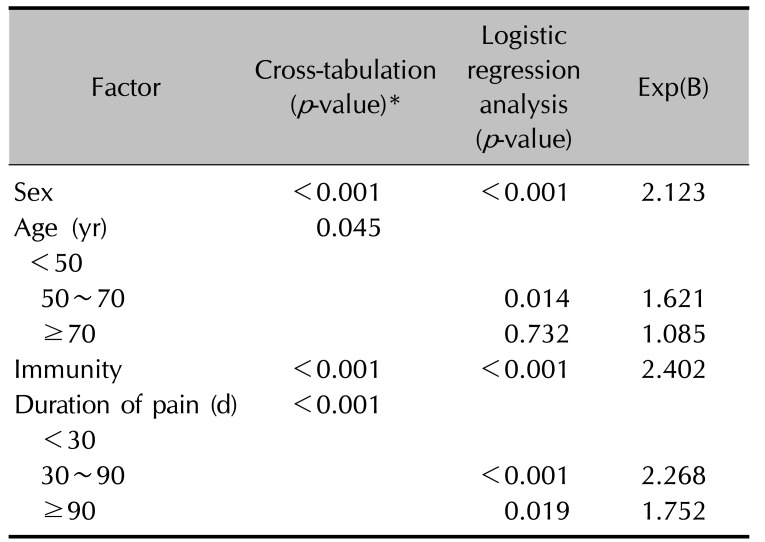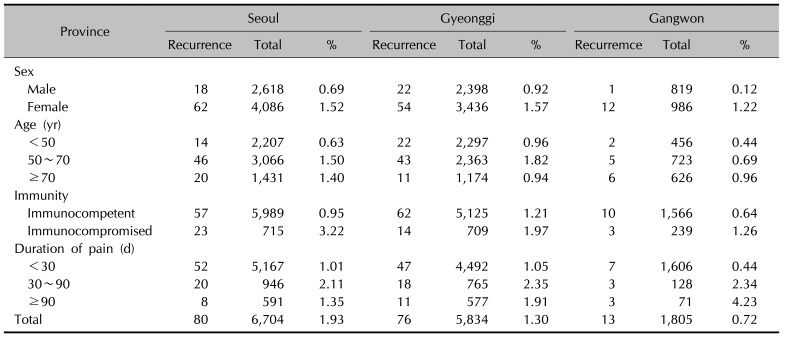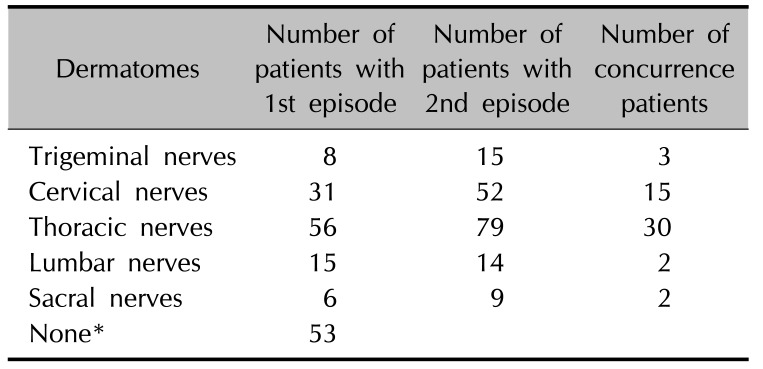A total of 169 herpes zoster recurrences were assessed in a total of 14,343 patients and the overall frequency of recurrence was 1.18%. Of 169 patients, 134 were confirmed by medical record review and 35 were confirmed by telephonic survey. Herpes zoster recurred in 41 of the 5,834 male patients (0.70%), and in 128 of the 8,509 female patients (1.50%). Of the 4,960 patients aged <50 years, 38 patients (0.77%) experienced recurrent herpes zoster, while 94 of the 6,148 patients aged 50~70 years (1.53%), and 37 of the 3,235 patients aged ≥70 years (1.14%), experienced a recurrence. Of 12,680 immunocompetent patients 129 (1.02%) experienced a recurrence, while 40 of 1,663 immunocompromised patients (2.41%) had a recurrence. Among the immunocompromised patients who experienced recurrence, 6 patients were taking antirheumatic drugs, 3 were taking anticancer drugs and 3 were taking immunosuppressive agent due to organ transplantation. Two of forty patients were diagnosed as hematologic malignancy and 1 of 40 had acquired immune deficiency syndrome. Twenty-one patients had diabetes mellitus as an underlying disease and 4 were status of chronic kidney disease. Lastly, herpes zoster recurred in 106 of 11,265 patients (0.94%) with duration of pain <30 days, in 41 of 1,839 patients (2.23%) with duration of 30~ 90 days, and in 22 of 1,239 patients (1.78%) with duration ≥90 days (
Table 1). Recurrence of herpes zoster was analyzed according to each of the patient factors by using the chi-square test. Recurrence was significantly associated with patient sex (
p<0.001), immunocompetence (
p <0.001), duration of pain (
p<0.001), and patient age (
p=0.045). Binomial logistic regression analysis showed that both sex (
p<0.001, Exp(B)=2.123) and immunocompetence status (
p<0.001, Exp(B)=2.402) were significantly associated with herpes zoster recurrence. This study showed statistically significant of recurrence rate between patients aged <50 years and those aged 50~70 years (
p=0.014, Exp(B)=1.621), but not those aged ≥70 years (
p=0.732, Exp(B)=1.085). Moreover, the recurrence of herpes zoster showed statistically significant among patients with a pain duration <30 days, 30~90 days (
p<0.001, Exp(B)=2.268), and ≥90 days (
p=0.019, Exp(B)=1.752) (
Table 2). The frequencies of recurrence of each province were assessed as 1.93% in Seoul, 1.30% in Gyeonggi and 0.72% in Gangwon. All of provinces showed higher frequent in female and immunocompromised patients. Both in Seoul and Gyeonggi province, patients aged 50~70 years, and in Gangwon province, patients aged ≥70 years showed the hightest frequency of recurrence (
Table 3). The interval between the first herpes zoster infection and the recurrence varied widely, from 1 to 31 years (mean, 5.1 years). Dermatological location of recurrent herpes zoster was divided in to trigeminal, cervical, thoracic, lumbar and sacral nerves. The recurrence was in the same dermatological location as the first episode in 52 out of 169 patients, and in a different dermatological location in 64. For the remaining 53 patients, data were unavailable or the patient did not remember the first location (
Table 4).
Table 1
Recurrence rate of herpes zoster, according to sex, age, immunocompetence, and duration of pain

|
Factor |
Number of patients with recurrence (n=169) |
Total number of Patients (n=14,343) |
Percentage of patients with recurrence (%) |
|
Sex |
|
|
|
|
Male |
41 |
5,834 |
0.70 |
|
Female |
128 |
8,509 |
1.50 |
|
Age (yr) |
|
|
|
|
<50 |
38 |
4,960 |
0.77 |
|
50~70 |
94 |
6,148 |
1.53 |
|
≥70 |
37 |
3,235 |
1.14 |
|
Immunity |
|
|
|
|
Immunocompetent |
129 |
12,680 |
1.02 |
|
Immunocompromised |
40 |
1,663 |
2.41 |
|
Duration of pain (d) |
|
|
|
|
<30 |
106 |
11,265 |
0.94 |
|
30~90 |
41 |
1,839 |
2.23 |
|
≥90 |
22 |
1,239 |
1.78 |

Table 2
Statistical analysis of factors influencing the recurrence of herpes zoster

|
Factor |
Cross-tabulation (p-value)*
|
Logistic regression analysis (p-value) |
Exp(B) |
|
Sex |
<0.001 |
<0.001 |
2.123 |
|
Age (yr) |
0.045 |
|
|
|
<50 |
|
|
|
|
50∼70 |
|
0.014 |
1.621 |
|
≥70 |
|
0.732 |
1.085 |
|
Immunity |
<0.001 |
<0.001 |
2.402 |
|
Duration of pain (d) |
<0.001 |
|
|
|
<30 |
|
|
|
|
30∼90 |
|
<0.001 |
2.268 |
|
≥90 |
|
0.019 |
1.752 |

Table 3
Recurrence rate of herpes zoster, according to provinces

|
Province |
Seoul |
Gyeonggi |
Gangwon |
|
Recurremce |
Total |
% |
Recurremce |
Total |
% |
Recurremce |
Total |
% |
|
Sex |
|
|
|
|
|
|
|
|
|
|
Male |
18 |
2,618 |
0.69 |
22 |
2,398 |
0.92 |
1 |
0819 |
0.12 |
|
Female |
62 |
4,086 |
1.52 |
54 |
3,436 |
1.57 |
12 |
0986 |
1.22 |
|
Age (yr) |
|
|
|
|
|
|
|
|
|
|
<50 |
14 |
2,207 |
0.63 |
22 |
2,297 |
0.96 |
2 |
0456 |
0.44 |
|
50∼70 |
46 |
3,066 |
1.50 |
43 |
2,363 |
1.82 |
5 |
0723 |
0.69 |
|
≥70 |
20 |
1,431 |
1.40 |
11 |
1,174 |
0.94 |
6 |
0626 |
0.96 |
|
Immunity |
|
|
|
|
|
|
|
|
|
|
Immunocompetent |
57 |
5,989 |
0.95 |
62 |
5,125 |
1.21 |
10 |
1,566 |
0.64 |
|
Immunocompromised |
23 |
0715 |
3.22 |
14 |
0709 |
1.97 |
3 |
0239 |
1.26 |
|
Duration of pain (d) |
|
|
|
|
|
|
|
|
|
|
<30 |
52 |
5,167 |
1.01 |
47 |
4,492 |
1.05 |
7 |
1,606 |
0.44 |
|
30∼90 |
20 |
946 |
2.11 |
18 |
765 |
2.35 |
3 |
128 |
2.34 |
|
≥90 |
8 |
591 |
1.35 |
11 |
577 |
1.91 |
3 |
71 |
4.23 |
|
Total |
80 |
6,704 |
1.93 |
76 |
5,834 |
1.30 |
13 |
1,805 |
0.72 |

Table 4
The number of patients according to involved anatomical dermatomes

|
Dermatomes |
Number of patients with 1st episode |
Number of patients with 2nd episode |
Number of concurrence patients |
|
Trigeminal nerves |
8 |
15 |
3 |
|
Cervical nerves |
31 |
52 |
15 |
|
Thoracic nerves |
56 |
79 |
30 |
|
Lumbar nerves |
15 |
14 |
2 |
|
Sacral nerves |
6 |
9 |
2 |
|
None*
|
53 |
|
|










 PDF
PDF ePub
ePub Citation
Citation Print
Print


 XML Download
XML Download